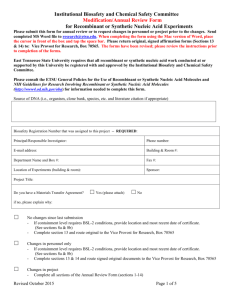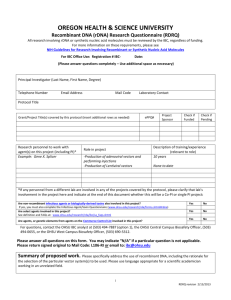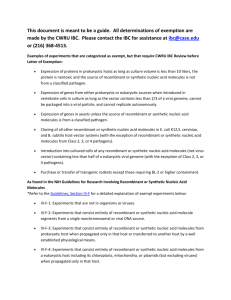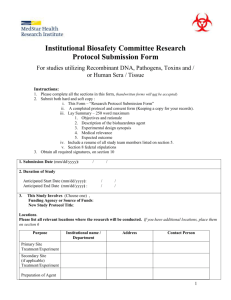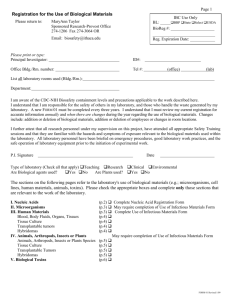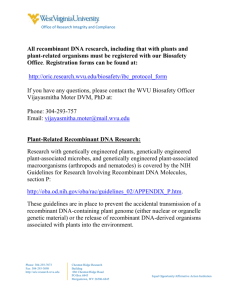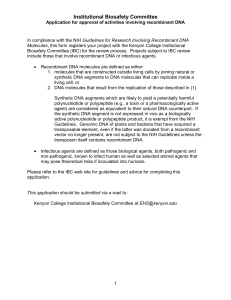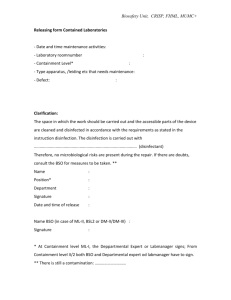Reviewer Form for Research Protocol Review
advertisement
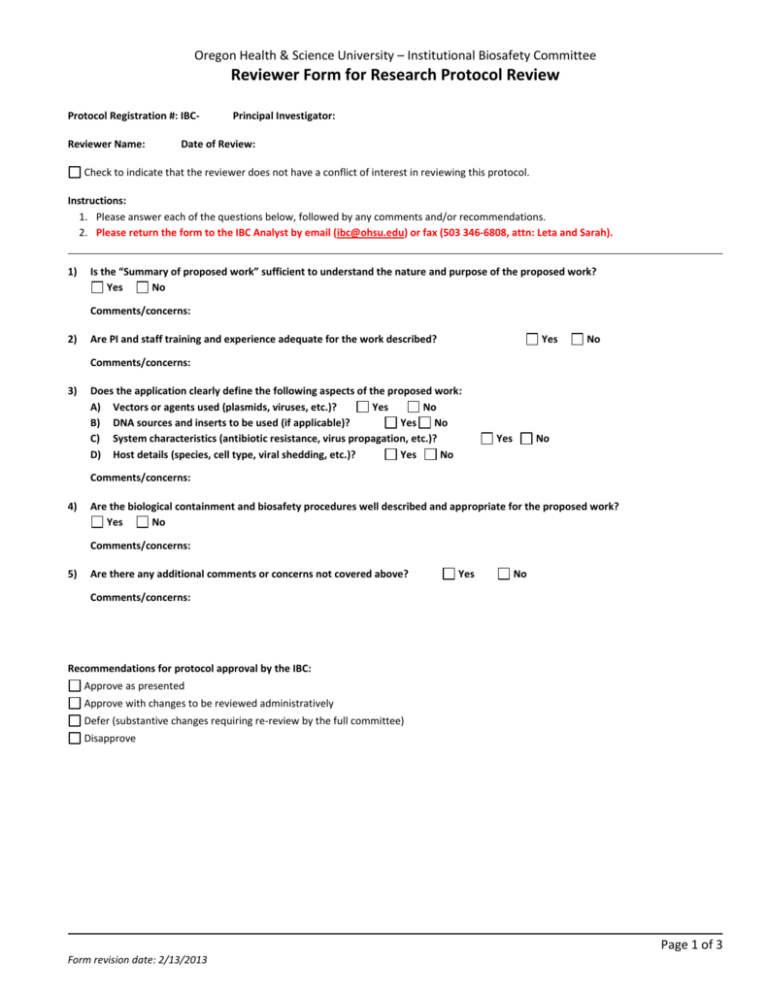
Oregon Health & Science University – Institutional Biosafety Committee Reviewer Form for Research Protocol Review Protocol Registration #: IBCReviewer Name: Principal Investigator: Date of Review: Check to indicate that the reviewer does not have a conflict of interest in reviewing this protocol. Instructions: 1. Please answer each of the questions below, followed by any comments and/or recommendations. 2. Please return the form to the IBC Analyst by email (ibc@ohsu.edu) or fax (503 346-6808, attn: Leta and Sarah). 1) Is the “Summary of proposed work” sufficient to understand the nature and purpose of the proposed work? Yes No Comments/concerns: 2) Are PI and staff training and experience adequate for the work described? Yes No Comments/concerns: 3) Does the application clearly define the following aspects of the proposed work: A) Vectors or agents used (plasmids, viruses, etc.)? Yes No B) DNA sources and inserts to be used (if applicable)? Yes No C) System characteristics (antibiotic resistance, virus propagation, etc.)? D) Host details (species, cell type, viral shedding, etc.)? Yes No Yes No Comments/concerns: 4) Are the biological containment and biosafety procedures well described and appropriate for the proposed work? Yes No Comments/concerns: 5) Are there any additional comments or concerns not covered above? Yes No Comments/concerns: Recommendations for protocol approval by the IBC: Approve as presented Approve with changes to be reviewed administratively Defer (substantive changes requiring re-review by the full committee) Disapprove Page 1 of 3 Form revision date: 2/13/2013 Oregon Health & Science University – Institutional Biosafety Committee Reviewer Form for Research Protocol Review Guidelines for Biosafety Protocol Review NIH Guidelines for Research Involving Recombinant DNA Molecules For all projects please consider (From NIH Guidelines, Section IV-B-2-b-(1)): (i) independent assessment of the containment levels required by the NIH ii) assessment of the facilities, procedures, practices, and training and expertise of personnel involved in recombinant DNA research For human gene transfer protocols please consider: (iii) ensuring that all aspects of Appendix M of the NIH Guidelines have been appropriately addressed by the Principal Investigator; and (v) for human gene transfer protocols selected for public RAC review and discussion, consideration of the issues raised and recommendations made as a result of this review and consideration of the Principal Investigator’s response to the RAC recommendations From NIH Guidelines, Section II-A-3 Comprehensive Risk Assessment: Factors to be considered in determining the level of containment include agent factors such as: virulence, pathogenicity, infectious dose, environmental stability, route of spread, communicability, operations, quantity, availability of vaccine or treatment, and gene product effects such as toxicity, physiological activity, and allergenicity. Any strain that is known to be more hazardous than the parent (wild-type) strain should be considered for handling at a higher containment level. Certain attenuated strains or strains that have been demonstrated to have irreversibly lost known virulence factors may qualify for a reduction of the containment level compared to the Risk Group assigned to the parent strain. SECTION III. EXPERIMENTS COVERED BY THE NIH GUIDELINES Section III-A: The deliberate transfer of a drug resistance trait to microorganisms that are not known to acquire the trait naturally, if such acquisition could compromise the use of the drug to control disease agents in humans, veterinary medicine, or agriculture, will be reviewed by RAC. Section III-B: Experiments Involving the Cloning of Toxin Molecules with LD50 of Less than 100 Nanograms per Kilogram Body Weight. Deliberate formation of recombinant or synthetic nucleic acid molecules containing genes for the biosynthesis of toxin molecules lethal for vertebrates at an LD50 of less than 100 nanograms per kilogram body weight (e.g., microbial toxins such as the botulinum toxins, tetanus toxin, diphtheria toxin, and Shigella dysenteriae neurotoxin). Section III-C: Experiments Involving the Deliberate Transfer of Recombinant DNA, or DNA or RNA Derived from Recombinant DNA, into One or More Human Research Participants. For an experiment involving the deliberate transfer into human research participants of either recombinant DNA, or DNA or RNA derived from recombinant DNA, or synthetic nucleic acid molecules or DNA or RNA derived from synthetic nucleic acid molecules that contain more than 100 nucleotides; or possess biological properties that enable integration in the genome (e.g. cis elements involved in integration); or have the potential to replicate in a cell; or can be translated or transcribed. No research participant shall be enrolled until the RAC review process has been completed (see Appendix M-I-B, RAC Review Requirements). Section III-D (experiments falling into any of the following categories below) Experiments Using Risk Group 2, Risk Group 3, Risk Group 4, or Restricted Agents as Host-Vector Systems Section III-D-1-a. Experiments involving the introduction of recombinant or synthetic nucleic acid molecules into Risk Group 2 agents will usually be conducted at Biosafety Level (BL) 2 containment. Experiments with such agents will usually be conducted with whole animals at BL2 or BL2-N (Animals) containment. Section III-D-1-b. Experiments involving the introduction of recombinant or synthetic nucleic acid molecules into Risk Group 3 agents will usually be conducted at BL3 containment. Experiments with such agents will usually be conducted with whole animals at BL3 or BL3-N containment. Section III-D-2. Experiments in Which DNA From Risk Group 2, Risk Group 3, Risk Group 4, or Restricted Agents is Cloned into Nonpathogenic Prokaryotic or Lower Eukaryotic Host-Vector Systems Section III-D-2-a. Experiments in which DNA from Risk Group 2 or Risk Group 3 agents is transferred into nonpathogenic prokaryotes or lower eukaryotes may be performed under BL2 containment. Experiments in which DNA from Risk Group 4 agents is transferred into nonpathogenic prokaryotes or lower eukaryotes may be performed under BL2 containment after demonstration that only a totally and irreversibly defective fraction of the agent's genome is present in a given recombinant. In the absence of such a demonstration, BL4 containment shall be used. The Institutional Biosafety Committee may approve the specific lowering of containment for particular experiments to BL1. Section III-D-3. Experiments Involving the Use of Infectious DNA or RNA Viruses or Defective DNA or RNA Viruses in the Presence of Helper Virus in Tissue Culture Systems Caution: Special care should be used in the evaluation of containment levels for experiments which are likely to either enhance the pathogenicity (e.g., insertion of a host oncogene) or to extend the host range (e.g., introduction of novel control elements) of viral vectors under conditions that permit a productive infection. In such cases, serious consideration should be given to increasing physical Page 2 of 3 Form revision date: 2/13/2013 Oregon Health & Science University – Institutional Biosafety Committee Reviewer Form for Research Protocol Review containment by at least one level. Section III-D-4. Experiments Involving Whole Animals This section covers experiments involving whole animals in which the animal's genome has been altered by stable introduction of recombinant or synthetic nucleic acid molecules, or nucleic acids derived therefrom, into the germ-line (transgenic animals) and experiments involving viable recombinant or synthetic nucleic acid molecule-modified microorganisms tested on whole animals. For the latter, other than viruses which are only vertically transmitted, the experiments may not be conducted at BL1-N containment. A minimum containment of BL2 or BL2-N is required. Section III-D-4-a. Recombinant or synthetic nucleic acid molecules, or DNA or RNA molecules derived therefrom, from any source except for greater than two-thirds of eukaryotic viral genome may be transferred to any non-human vertebrate or any invertebrate organism and propagated under conditions of physical containment comparable to BL1 or BL1-N and appropriate to the organism under study. Animals that contain sequences from viral vectors, which do not lead to transmissible infection either directly or indirectly as a result of complementation or recombination in animals, may be propagated under conditions of physical containment comparable to BL1 or BL1-N and appropriate to the organism under study. Section III-D-4-b. For experiments involving recombinant or synthetic nucleic acid molecules, or DNA or RNA derived therefrom, involving whole animals, including transgenic animals, and not covered by Sections III-D-1, Experiments Using Human or Animal Pathogens (Risk Group 2, Risk Group 3, Risk Group 4, or Restricted Agents as Host-Vector Systems), or III-D-4-a, Experiments Involving Whole Animals, the appropriate containment shall be determined by the Institutional Biosafety Committee. Section III-D-6. Experiments Involving More than 10 Liters of Culture. The appropriate containment will be decided by the Institutional Biosafety Committee. Where appropriate, Appendix K, Physical Containment for Large Scale Uses of Organisms Containing Recombinant DNA Molecules, shall be used. Appendix K describes containment conditions Good Large Scale Practice through BL3-Large Scale. Section III-E (experiments falling into any of the following categories below) Experiments not included in categories A-D or F, are considered Category E. For example, experiments in which all components are derived from non-pathogenic prokaryotes and non-pathogenic lower eukaryotes. Section III-E-1. Experiments Involving the Formation of Recombinant or Synthetic Nucleic Acid Molecules Containing No More than Two-Thirds of the Genome of any Eukaryotic Virus. Recombinant or synthetic nucleic acid molecules containing no more than two-thirds of the genome of any eukaryotic virus (all viruses from a single Family being considered identical may be propagated and maintained in cells in tissue culture using BL1 containment.) For such experiments, it must be demonstrated that the cells lack helper virus for the specific Families of defective viruses being used. The DNA may contain fragments of the genome of viruses from more than one Family but each fragment shall be less than two-thirds of a genome. Section III-E-3. Experiments Involving Transgenic Rodents. This section covers experiments involving the generation of rodents in which the animal's genome has been altered by stable introduction of recombinant or synthetic nucleic acid molecules, or nucleic acids derived therefrom, into the germ-line (transgenic rodents). Page 3 of 3 Form revision date: 2/13/2013
